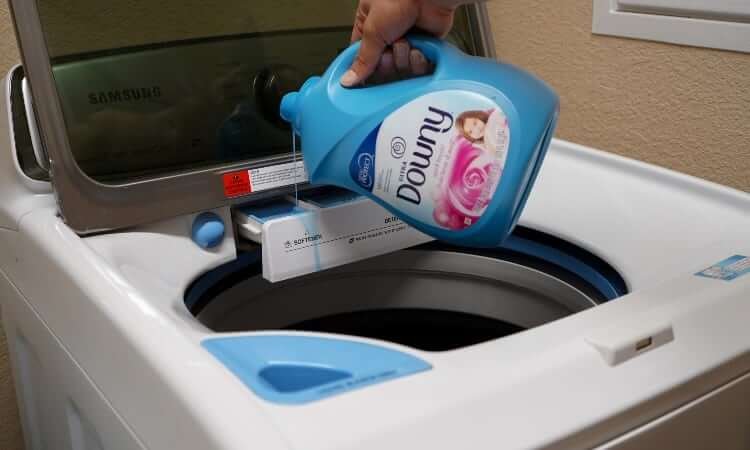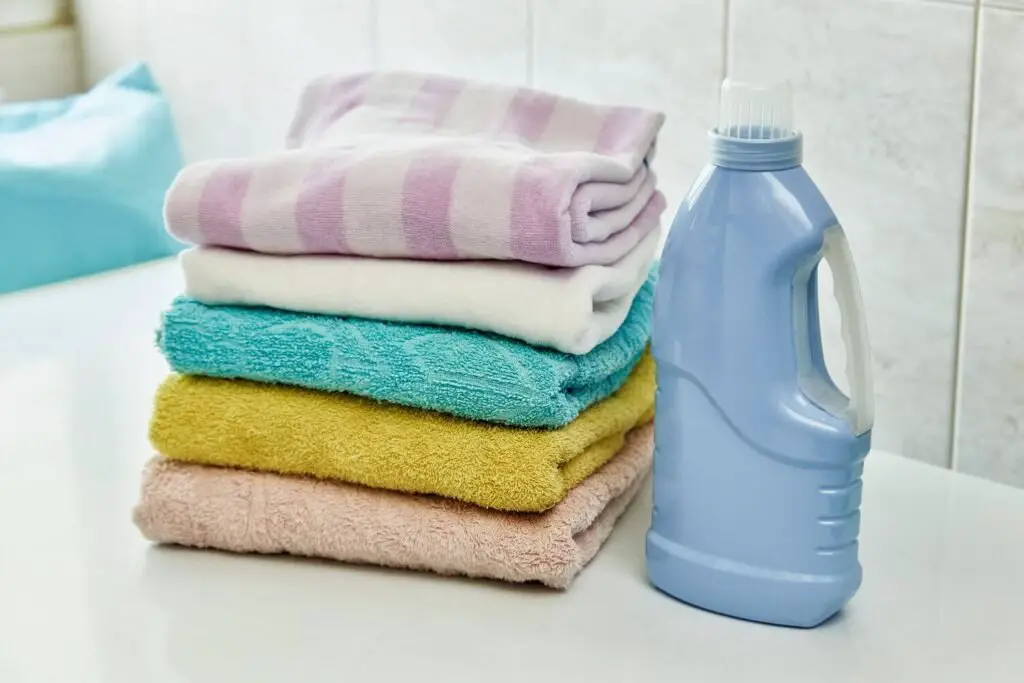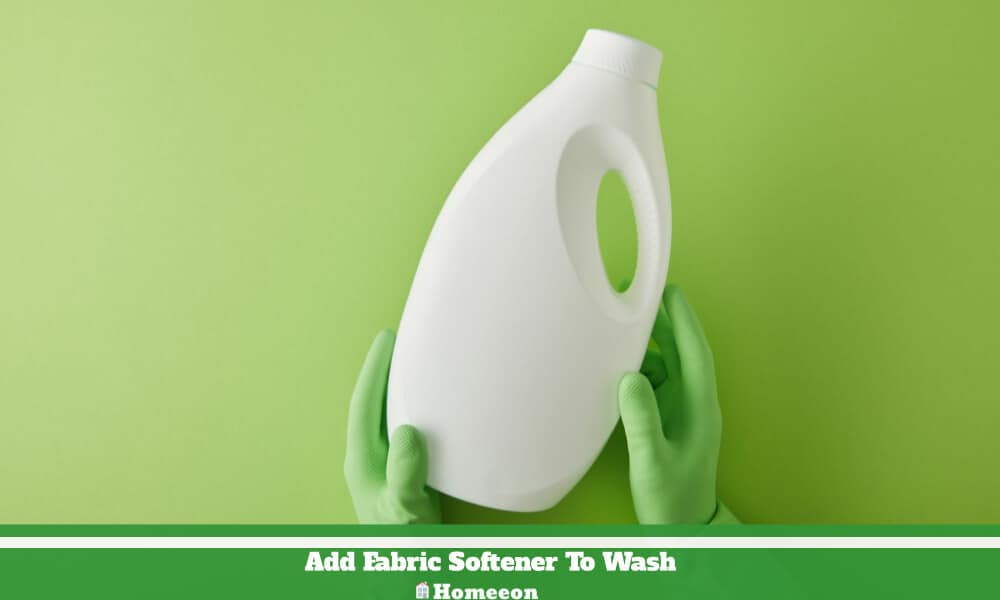Last Updated on July 31, 2023 By Emma W. Thomas
Add fabric softener to the washing machine during the rinse cycle. The rinse cycle is designed to remove detergent residue and add fabric softener to the clothes for a soft and fresh feel.
When To Add Fabric Softener To Wash
Fabric softener is a must-have laundry staple for many people looking to achieve soft, fresh-smelling, and static-free clothes. However, the question of when to add fabric softener to the wash is a common one. Are you unsure about the right time to incorporate fabric softener into your laundry routine? Allow us to guide you through the process with this helpful listicle:
- Read the clothing care label:
- Before adding fabric softener, it’s crucial to check the care label instructions on your garments.
- Some fabrics, like activewear or microfiber materials, may not be recommended for use with fabric softener.
- Choose the right type:
- Select a fabric softener that suits your needs. There are liquid fabric softeners, dryer sheets, and even eco-friendly options available.
- Ensure the fabric softener you choose is compatible with your washing machine type.
- Regular laundry cycle:
- If you’re using a standard washing machine, add a fabric softener during the rinse cycle.
- Typically, there is a specific dispenser or compartment labeled for fabric softener.
- High-efficiency (HE) machines:
- If you own a high-efficiency washing machine, consult the user manual to determine when and how to add fabric softener.
- Some HE machines have separate compartments for fabric softener, while others require a specific time during the wash cycle.
- Alternative options:
- For those who prefer not to use fabric softener throughout the entire wash, consider using a fabric softener ball or a fabric softener dispenser ball.
- These handy tools release the softener gradually during the rinse cycle.
- Towels and sheets:
- Adding fabric softener to your towels and sheets can enhance their softness and make them feel luxurious.
- Remember that high concentrations of fabric softener might reduce the absorbency of towels.
- Baby clothes and sensitive skin:
- When washing baby clothes or items for individuals with sensitive skin, it’s wise to opt for a hypoallergenic fabric softener.
- Adding softener during the final rinse cycle can help reduce any potential skin irritations.
- Avoid adding fabric softener:
- Some clothes should not be treated with fabric softener, such as flame-resistant fabrics or technical sportswear.
- These garments often have special coatings that can be affected by fabric softener.
- Consider your preferences:
- Experiment with different methods and timings to find what works best for you.
- Some people prefer to add fabric softener to every load, while others reserve it for certain items or occasions.
Remember to keep in mind that moderation is key when using fabric softener. It’s advisable not to overdose on fabric softener, as it may lead to a build-up of residue on clothes or decrease the absorbency of certain fabrics. Follow the instructions on the packaging for the recommended amount.
When To Avoid Using Fabric Softener?
1. When Washing Microfiber Cloths
Utilizing fabric softener when washing microfiber cloths is not recommended. Microfibers have unique properties — they trap and hold dust and dirt, making these cloths perfect for cleaning and dusting. However, the usage of fabric softener can clog the microscopic channels within the fibers, undermining their effectiveness.
2. On Towels
Although fabric softener can make towels feel fluffy, it can also make them less absorbent. This is because the softener creates a waxy, water-repelling layer on the fibers. Therefore, it’s advised to avoid using a fabric softener for towels to maintain their absorbency.
3. While Washing Sportswear
Sportswear often consists of materials that are either moisture-wicking or water-resistant. Using fabric softener can inhibit these properties, diminishing the effectiveness of the athletic garments. Hence, such clothes should typically be washed without fabric softener.
4. On Flame-Resistant Clothing
Fabric softeners can wash away the flame-resistant qualities of certain clothes, making them less safe. Given the inherent importance of these properties, avoid using fabric softener on such clothing to uphold safety levels.
5. With Baby Clothing
Some fabric softeners may contain harmful chemicals or fragrances that can irritate sensitive skin, particularly that of newborns or babies. Thus, it is advisable to avoid using fabric softeners on baby items unless they are specifically labeled as baby-friendly or hypoallergenic.
6. For Denim
While fabric soften might seem like a good idea for a stiff pair of jeans, it can actually break down the fibers and cause your denim to lose shape. To maintain the longevity and shape of your denim, it is recommended to skip the fabric softener.
7. On Items with Spandex
Stretchy fabrics, such as those containing spandex or Lycra, should not be washed with fabric softener. The chemicals present in fabric softeners can damage these types of materials, leading to a potential loss in elasticity.
Top-Loader Machines

1. Measure the recommended amount of fabric softener as indicated in the instructions on the label
2. Pour the fabric softener into your machine’s dispenser. For most top loaders, the fabric softener dispenser is found on the central column and is marked by a flower or star icon
3. Start your wash. Fabric softener will be released during the spin cycle leaving your clothes fresh and soft
Using A Front-Loader
Front-load machines are the easiest to use when it comes to adding detergents and softeners. Here are the steps you need to follow:
1. Measure the recommended amount of fabric softener
2. Pour the measured softener into the washers softener automatic dispenser tray
3. Start your cycle and let the fabric softener work its magic
How To Add Fabric Softener To A Machine With No Dispenser
For some washing machines, especially the semi-automatic ones, you have to know when to add fabric softeners since they don’t come with dispensers. If your washing machine doesn’t have an automatic dispenser, worry not. We got you.
You need to know the right time to add fabric softener, and that’s during the rinse cycle. This is because, if added during the wash cycle, it is likely to be washed away. When your machine is just about to start the rinse cycle, add the recommended amount of softener mixed with water to the machine. It is important to mix your softener with water and avoid direct contact with clothes to prevent stains.
Can You Put Fabric Softener Straight Into The Washing Machine?
Yes, if your machine doesn’t have a dispenser, you can add fabric softener directly to the machine. You only need to ensure that you use the right amount of softener and dilute it with water to avoid staining your clothes. Another point to note is that you need to add a fabric softener during the rinse cycle. This is important because adding it in the wash cycle will have it washed out, and your clothes will look as if no softener was used.
What Is A Fabric Softener, And What Does It Do?
Fabric softener or conditioner works to condition and soften your clothes, making them feel soft and less scratchy on your skin. Most brands of fabric softeners have a fragrance that leaves your clothes smelling fresh days after they have been washed. Fabric softener also has other benefits that are not well-known. Let’s have a look at these other benefits of fabric conditioner:
1. Helps To Protect And Care For Your Clothes
Fabric softener makes clothes softer and smoother, thus reducing clinginess caused by static. It also conditions the fibres of your garment, making them look new for much longer. It helps cushion garments from severe effects of wear and tear.
2. Saves You Ironing Time By Reducing Creases
When you add fabric softener to your clothes, they come out of the washing machine less creased. The fibers are also smooth, thus making ironing easier and faster.
3. Helps To Reduce The Risk Of Irritation For Those With Sensitive Skin
If you or anyone in your house is prone to skin sensitivities and mild skin reactions, using fabric softener on clothes will help reduce the risk of irritation. For people suffering from eczema and other skin conditions, fabric softener will help prevent irritation by scratchy or rough materials.
Can I Use Fabric Softener On All Laundry?

Fabric softener is safe to use on all fabric types, but some items are best washed without. A good example is towels and microfiber cloths meant to absorb water or moisture. Fabric softeners often leave a silky film on the surface of clothes to give a smooth feel, But this film affects the absorbency of the material.
To ensure your towels remain absorbent but still soft and fluffy, it is advisable to alternate washing with and without fabric softener. For sportswear is meant to absorb sweat, handle with care and follow washing instructions on the garments label. Always ensure you read the packaging on your fabric softener for instructions on when you can use it.
Conclusion
Fabric softener makes laundry days more bearable and leaves garments soft and smelling fresh for a long. They also help reduce irritation from scratchy or rough garments. People with sensitive skin should consider using fabric softeners for most of their garments to reduce the effects of friction and rough garments. Before using a fabric softener, it is advisable to read the instructions on the label and the care label on all your garments.
Always ensure you wash your hands thoroughly after touching or handling fabric softener to reduce the risk of irritation on your skin. People with very sensitive skin may sometimes, though rare, notice a mild reaction if they allow undiluted fabric conditioner to sit on the skin for long periods. We hope that this post was enlightening and you now know when to add fabric softener and how to do it correctly. Enjoy your laundry and iron days with your favourite fabric conditioner.
References:
https://www.getnimnim.com/blog/when-should-you-use-a-fabric-softener
https://silverbobbin.com/when-to-add-fabric-softener-to-wash/
Emma is a graduate of Domestic Science or Family and Consumer Sciences (Home Economics) from the University of Wisconsin. She has 7 years of experience Working with the strategic section of BestBuy and now writing full-time for Homeeon.
From Managing the Home, Interiors, Cleaning, and Exteriors to Gardening and everything about Making A Home Liveable – is her passion and this Homeeon is the result of this.
Emma loves decorating her home with the best stuff found online. She cares about quality over anything and writes reviews about them here in Homeeon. Get in touch with her over Pinterest.
Keep reading her blogs.
